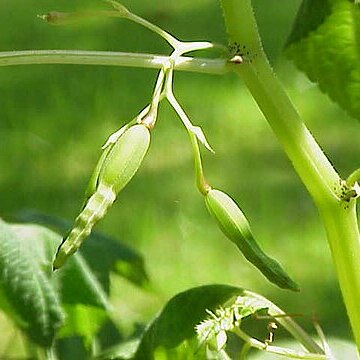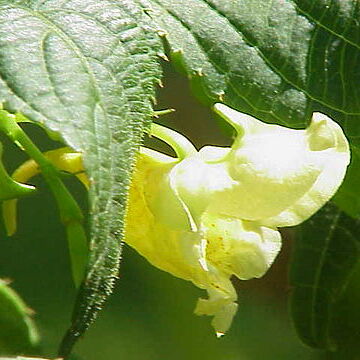Plants annual, 30-50 cm tall, rarely taller. Stem erect, green or purple-tinged basally, many branched, pubescent or subglabrous basally. Leaves alternate, sessile or subsessile; petiole with 2 globose basal glands; leaf blade ovate or ovate-lanceolate, 5-15 × 1.5-2 cm, apices of teeth with marginal glands, abaxially pubescent, adaxially sparsely strigose, lateral veins 7-9 pairs, base subrounded, margin sharply serrate, apex acuminate. Inflorescences in leaf axils, 1-3-flowered, shortly pedunculate; pedicels bracteate at middle; peduncles, pedicels, and bracts brown pubescent; bracts persistent, setose or setose-lanceolate, apex long mucronulate. Flowers golden-yellow, purple spotted, ca. 2.5 cm deep. Lateral sepals 2, ovate, sparsely pubescent, apex mucronulate. Lower sepal broadly funnelform, abruptly narrowed into a curved spur ca. 1 cm. Upper petal broadly orbicular, abaxial midvein green, cornute-cristate, crista conspicuous in flowering buds; lateral united petals not clawed, 2-lobed; basal lobes orbicular, short; distal lobes oblong-dolabriform; auricle inflexed, narrow. Anthers obtuse. Capsule linear, 2.5-3 cm, glabrous or sparsely hairy. Fl. Jul-Sep. 2n = 14.
More
An erect herb. It grows to 50 cm high. The leaves are alternate and have stalks. They are oval to sword shaped and have teeth along the edge. The base is narrowed into the stalk. The flowers are yellow. They are usually on two flowered stalks in the axils of leaves. The spur is short. It is slightly curved. The fruit is a capsule.


